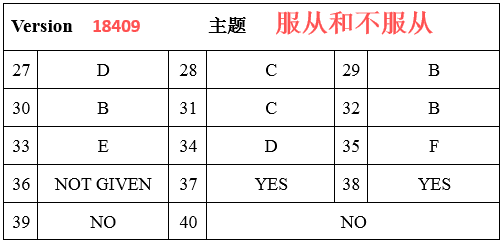托福阅读作为托福考试中比较重要重要的一部分,如何能够通过比较通透的对托福阅读了解而拿到托福高分,下面小编就和大家分享突破新托福阅读之基础理解和篇章应用,来欣赏一下吧。
突破新托福阅读之基础理解和篇章应用
新托福考试阅读部分约为60到100分钟,包括3到5篇文章,每篇650至750个单词,每篇对应12至14道试题。题目类型包括:图表题(schematic table),篇章总结题(prose summary)(从给出的选项中选择能够概括文章内容的句子),词汇题(vocabulary)(在一定的上下文中),指代关系题(reference),简化句子题(sentence simplification),插入文本题(insert text),事实信息题(factual information),推断题(inference),修辞目的题(rhetorical purpose)以及否定排除题(negative factual information)(例如,下列各项均正确除……之外。)在完成答题的过程中,同学们可以使用"复查"功能瞬间找出没有回答的题目,而不必每道题都检查一遍。
从两大题型入手突破新托福考试阅读部分可以概括为两种题型,包括基础理解题和篇章应用题。基础理解题重点考查考生对基础项目的理解,特别是考生根据文章的词汇、句法和语义内容理解把握重要信息的能力。具体分析起来,新托福的基础理解题除插入文本题和修辞目的题外,主要仍是旧托福出现过的传统题型。
篇章应用题不仅仅要求根据词汇、句法和语义内容理解具体的点和大意,而且要求认定文章的结构和目的。对全篇有系统深入的理解,从而进行重构是篇章应用题的关键目标。它要求考生能从文章提取和记忆重要的信息并将其应用在新的情境中。如果考生能在头脑中抽象出一个框架,他就必然能根据课文重构中心思想和相关重要信息。
托福阅读素材之慢艺术
Slow art is art created or presented in a way that encourages unhurried viewing and deep contemplation; a work of art that unfolds over along time.
“慢艺术”是为了鼓励人们从容观看和深思而创造或展示的艺术,是让你花长时间去欣赏的一件艺术品。
Famous art critic Robert Hughes wrote that “Wehave had a gutful of fast art and fast food. What weneed more of is slow art: art that holds time as avase holds water; art that grows out of modes ofperception and whose skill and doggedness makeyou think and feel; art that isn't merely sensational, that doesn't get its message across in 10 seconds, that isn't falsely iconic, that hooks onto something deep-running in our natures.”
著名艺术评论家罗伯特•休斯曾写道:“我们已经受够了快艺术和快餐。我们更需要的是慢艺术:那些能承载时间的艺术,就像花瓶能承载水一样;那些领会了各种感知方式,灵活又固执地让你去思考和感受的艺术;那些不只带来一时震撼,也不会在10秒内迅速传递信息的艺术,这种艺术不是虚假的偶像文化,而是直抵人性深处的真实。”
A number of museums now offer “slow art” tours or days that encourage visitors to take their time. Rather than check master works off a list as if on a scavenger hunt, you can make asprawling museum digestible and personal by seeking out only those works that dovetail with your interests.
不少博物馆现在都提供“慢艺术”游览项目或鼓励游客从容观赏的“慢艺术日”。你不必像食腐动物狩猎一般把大师杰作飞速地一览而尽,而是可以找出那些对你口味的作品,然后慢慢地去消化吸收,让你的博物馆之旅变得个性化。
托福阅读真题原题+题目
As the twentieth century began, the importance of formal education in the United States increased. The frontier had mostly disappeared and by 1910 most Americans lived in towns and cities. Industrialization and the bureaucratization of economic life combined with a new emphasis upon credentials and expertise to make schooling increasingly important for economic and social mobility. Increasingly, too, schools were viewed as the most important means of integrating immigrants into American society.
The arrival of a great wave of southern and eastern European immigrants at the turn of the century coincided with and contributed to an enormous expansion of formal schooling. By 1920 schooling to age fourteen or beyond was compulsory in most states, and the school year was greatly lengthened. Kindergartens, vacation schools, extracurricular activities, and vocational education and counseling extended the influence of public schools over the lives of students, many of whom in the larger industrial cities were the children of immigrants. Classes for adult immigrants were sponsored by public schools, corporations, unions, churches, settlement houses, and other agencies.
Reformers early in the twentieth century suggested that education programs should suit the needs of specific populations. Immigrant women were one such population. Schools tried to educate young women so they could occupy productive places in the urban industrial economy, and one place many educators considered appropriate for women was the home.
Although looking after the house and family was familiar to immigrant women, American education gave homemaking a new definition. In preindustrial economies, homemaking had meant the production as well as the consumption of goods, and it commonly included income-producing activities both inside and outside the home, in the highly industrialized early-twentieth-century United States, however, overproduction rather than scarcity was becoming a problem. Thus, the ideal American homemaker was viewed as a consumer rather than a producer. Schools trained women to be consumer homemakers cooking, shopping, decorating, and caring for children efficiently in their own homes, or if economic necessity demanded, as employees in the homes of others. Subsequent reforms have made these notions seem quite out-of-date.
1. It can be inferred from paragraph 1 that one important factor in the increasing importance of education in the United States was
(A) the growing number of schools in frontier communities
(B) an increase in the number of trained teachers
(C) the expanding economic problems of schools
(D) the increased urbanization of the entire country
2. The word means in line 6 is closest in meaning to
(A) advantages
(B) probability
(C) method
(D) qualifications
3. The phrase coincided with in line 8 is closest in meaning to
(A) was influenced by
(B) happened at the same time as
(C) began to grow rapidly
(D) ensured the success of
4. According to the passage , one important change in United States education by the 1920's was
that
(A) most places required children to attend school
(B) the amount of time spent on formal education was limited
(C) new regulations were imposed on nontraditional education
(D) adults and children studied in the same classes
5. Vacation schools and extracurricular activities are mentioned in lines 10-11 to illustrate
(A) alternatives to formal education provided by public schools
(B) the importance of educational changes
(C) activities that competed to attract new immigrants to their programs.
(D) the increased impact of public schools on students.
6. According to the passage , early-twentieth century education reformers believed that
(A) different groups needed different kinds of education
(B) special programs should be set up in frontier communities to modernize them
(C) corporations and other organizations damaged educational progress
(D) more women should be involved in education and industry
7. The word it in line 22 refers to
(A) consumption
(B) production
(C) homemaking
(D) education
PASSAGE 47 DCBAD AC
托福相关文章:
★ 学习资料库
★ 海棠无香
★ SAT考题又重复 中国学生接下来该怎么办
★ 英语口语3000句第一课(1-94)
★ 2020托福听力5大出题规律是什么
★ 2020托福听力要提分的要求有哪些
★ 美好的校园时光
★ “天气热”的十大英语表达
★ 推免三分钟自我介绍范文5篇
★ 学习资料库
新托福阅读之基础理解和篇章应用
上一篇:从题型层面剖析托福阅读备考
下一篇:返回列表





